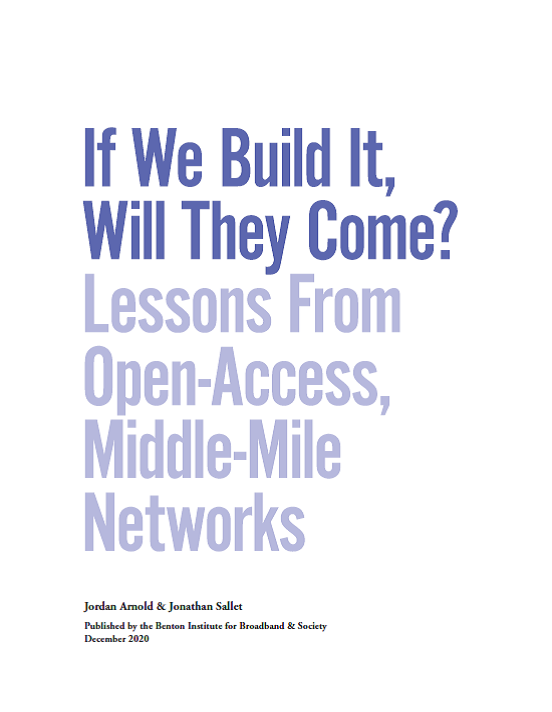Jonathan Sallet
Open-Access, Middle-Mile Networks: Deployment and Competition
Residential and small-business customers have too few options for fixed, robust broadband service, what we refer to as “High-Performance Broadband.” Solving our deployment and competition problems requires the construction of new broadband networks. In other words, we need more competition, and we need more broadband deployment. Our new policy brief concentrates on one solution—the construction of open-access, middle-mile networks.
Residential and small-business customers have too few options for fixed, robust broadband service, what we refer to as “High-Performance Broadband.” Fixing our deployment and competition problems requires the construction of new broadband networks.


What 2020 Taught Us About Broadband
We’re not going back to broadband circa 2019. Every aspect of life is going to have a significant virtual component from here on. That’s the lesson we’ve learned in 2020 about the use of broadband networks by people in their homes. Residential broadband access has become crucial to work and learn, to schedule and attend remote visits with a doctor, and to remain connected with family and friends—especially with multiple members of the household online at the same time.
Broadband for America Now
In October 2019, the Benton Institute for Broadband & Society issued Broadband for America’s Future: A Vision for the 2020s. The agenda was comprehensive, constructed upon achievements in communities and insights from experts across the nation. The report outlined the key building blocks of broadband policy—deployment, competition, community anchor institutions, and digital equity (including affordability and adoption).

Jonathan Sallet's Written Statement for the Reimagine New York Commission
The Benton perspective is this: Everyone in America should be able to use High-Performance Broadband, by which I mean broadband connections to the home that are robust and future-proof. Broadband competition is more important than ever because—in our current crises and beyond—America has fast-forwarded into its broadband future. Yet, New York, like the nation, has too little competition in fixed broadband to ensure that all people have the advantage of competitive pricing, quality, customer service, and innovation.

Moving forward together: Supporting state and local broadband leadership
In the midst of the COVID-19 crisis, the General Assembly is considering Gov. Northam’s request to increase funding to bring better broadband to all Virginians. Such support is important, as students stay home and learn, adults stay home and work, and seniors stay home even as they visit their doctor. Funding for broadband would be an important step — and a wake-up call to the federal government. Virginia’s broadband challenges are multifaceted. In rural areas, nearly a third of households have no access to broadband.
Make broadband far more affordable
We urge Congress to establish a broadband credit — call it America’s Broadband Credit — to ensure many more people can afford high-speed Internet access. Congress could set a household subsidy of $50 per month, which is roughly the cost of medium-tier broadband plans in urban settings (and it could provide a higher subsidy for tribal lands). That subsidy would allow anyone and any device in the household to be connected to the Internet, simultaneously, which is how so many families today are operating.

America’s Broadband Moment: Creating a Broadband Competition Policy Agenda
Broadband competition is more important than ever because – in these crises and beyond – America has fast-forwarded into its broadband future. But broadband competition is limited: At a typical broadband speed of 100/10 Mbps, at least 80% of Americans face either a monopoly (no choice) or a duopoly (only one choice) for fixed service. It’s worse in rural America, where monopoly is even more prevalent. The impact is obvious: higher prices, lower quality and/or slowed innovation limiting the ability of people to participate fully in society and the economy.
America’s Broadband Moment: Making Broadband Affordable
The time has come for Congress to establish a broadband credit—call it America’s Broadband Credit (ABC)—to ensure that people who can’t afford broadband can use broadband. The debate on whether broadband is a luxury or an essential connection to society is over. Broadband is critical, as Americans have now learned as they work, study, consult doctors, socialize, shop—and really lead their lives from home. But for too many, especially the newly unemployed, the cost of broadband service is not affordable.

America’s Broadband Moment
The debate on whether broadband is a luxury or an essential connection to society is over. More than twice as many people are now using residential broadband during business hours as before the COVID-19 crisis. Over 55 million students have been impacted by school closures. The use of telehealth has skyrocketed. This, I believe, is our broadband moment: a hinge of history that will determine whether today’s residential broadband is fit for the changed world in which we inhabit or whether its limits work to disadvantage those that are not equipped to use it.

